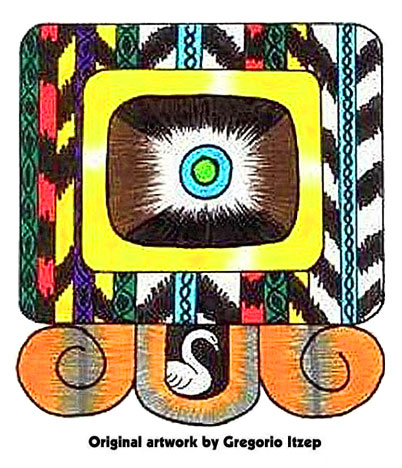
Toj Trecena
by Kenneth Johnson
There are many names for this day sign, but perhaps the most common English translation is “water.” In Yucatec Maya, however, the word muluc literally means “something that is gathered up” or “collected” in reference to the rain clouds that gather up or collect in the sky before a storm.
In Yucatan there are folktales which speak of how the power and energy of the rain was “collected” in water pots or vases, which were kept by the chacs, the helpers of the rain god. During a rain, the chacs pour forth the waters of abundance from their rain pots. Fierce storms occur when the rain pots, overburdened with water, burst open unexpectedly. A Mayan folktale tells the story of a runaway boy who takes refuge with a kindly old man who lives alone in the jungle. The old man leaves the boy on his own in the house, but insists that he must never open the jars in the back room. Of course, this is exactly what the boy does. The result is a tremendous tropical storm, quelled only when the old man returns to set things to right. He is, in reality, a chac, and the boy has opened his “collection” (muluc) of rain pots.
But this day sign can symbolize fire as well as water. In the Popol Vuh or Mayan Creation Epic it is written that when the “original people” first left their homeland in Tulan, they wandered in the darkness, guided only by the dim light of the morning star. Their leaders were the B’alam’eb, the four “Jaguar Men” who, along with their wives, were the forefathers of humanity. These leaders were in constant communication with their guardian deities, the most important of whom was Tohil or Tojil.
The original people wandered until they reached the mountain called Hacavitz. It was here that the forefathers made their offerings to Father Sun at the dawning of this new World Age. When the sun first rose upon the Fourth World, the gods of the forefathers were changed into stone. To this day, Mayan altars and sacred places in the wilderness are often places of stone.
This day sign is dedicated to the god Tojil or Tohil. Its K’iche’ name, Toj, contains part of the name of the god. In the ancient form of the Mayan language that was spoken in the great cities of Tikal and Palenque, this deity was called Kawiil. One of his legs takes the form of a serpent and he holds a scepter. In central Mexico this same deity was called Tezcatlipoca or Smoking Mirror. While Tezcatlipoca was sometimes regarded as a god of magic and sorcery, he was also renowned as a god of healing. Contemporary Aztec healers still reverence Tezcatlipoca as the archetypal progenitor of their art.
This important day-sign participates in the sacred energy of two different elements, Water and Fire. In terms of Water, Toj represents the rain that nurtures the earth. In terms of Fire, its connection with the god Tojil makes the day-sign Muluc or Toj symbolic of the Sacred Ceremonial Fire.
The most fundamental of Mayan rituals is the Fire Ceremony. Tojil is the spirit of the sacred ceremonial fire and the deity who rules over the ritual flame. This is the fire of Ajaw; it is the Heart of Sky and the Heart of Earth. The flames of the Fire Ceremony are pure. Other elements, like earth and water and air, can become polluted by the unthinking actions of human beings, but fire always remains pure and is thus the perfect medium for burning away our misdeeds and our debts to the world.
Thus Muluc is the sign of offering. There are many offerings which we may place in the sacred fire to be consumed. Candles, incense, tobacco, sugar, flowers, liqueur and sweet-smelling herbs may all be cast into the flames. Some of these offerings honor our ancestors, or the four elements, or the spirits of sacred places, as well as the spirits of the day-signs themselves. But most importantly, our offerings are a kind of payment, a debt we pay in order to correct our imbalances and bring us back into harmony. In terms of contemporary spirituality, one could say that this is the sign of paying our karmic debts.
At this time we humbly acknowledge our karmic debts and assert our intention to “pay it all back” by placing our lives in harmony. Make atonement for all disequilibrium and be thankful for all that is in balance. This is a day on which to give thanks for everything we have received in our life, the good and the bad.
http://www.jaguarwisdom.org

